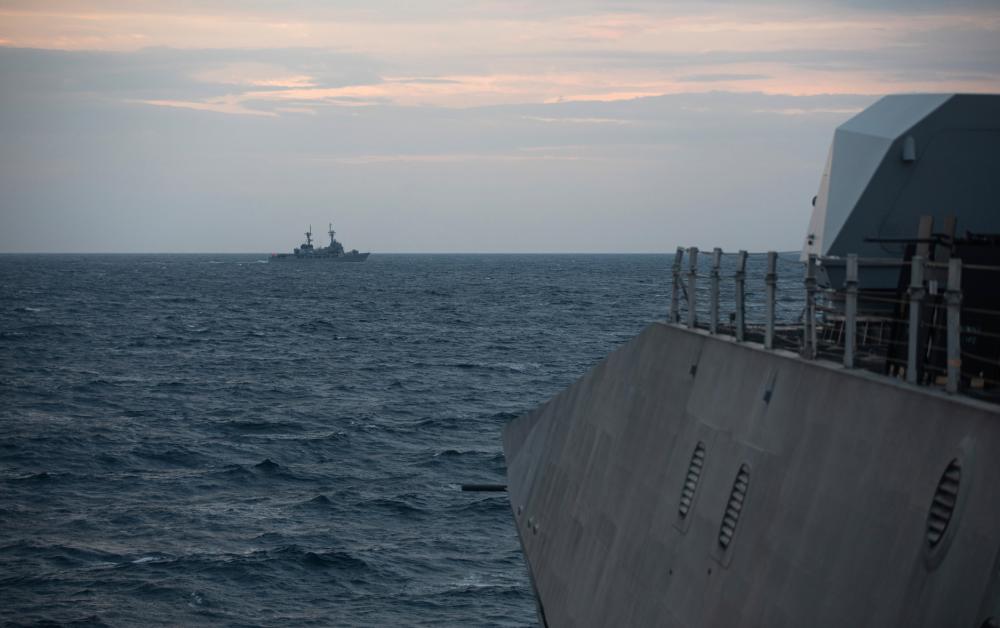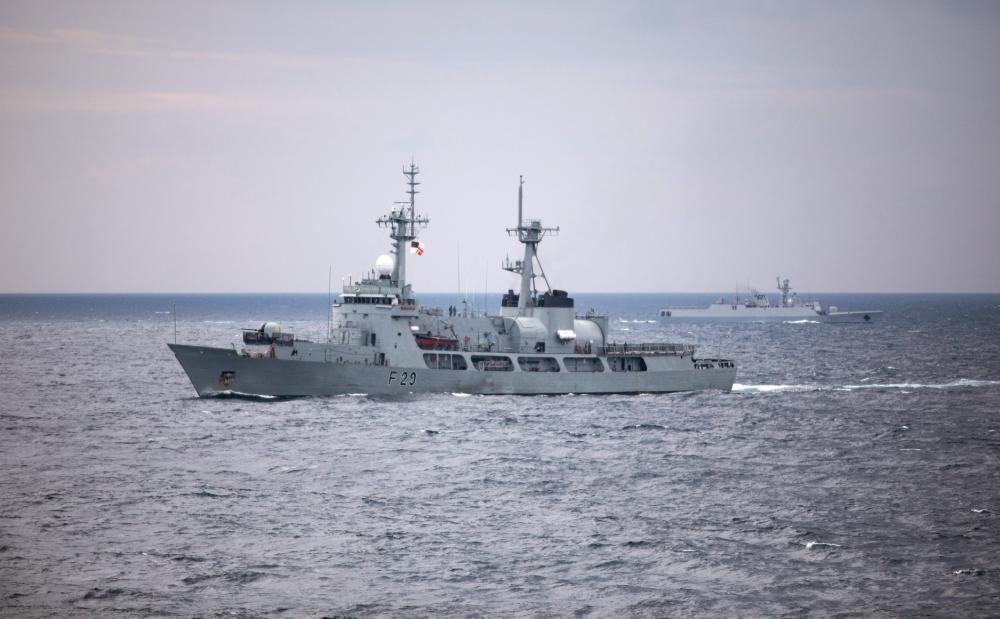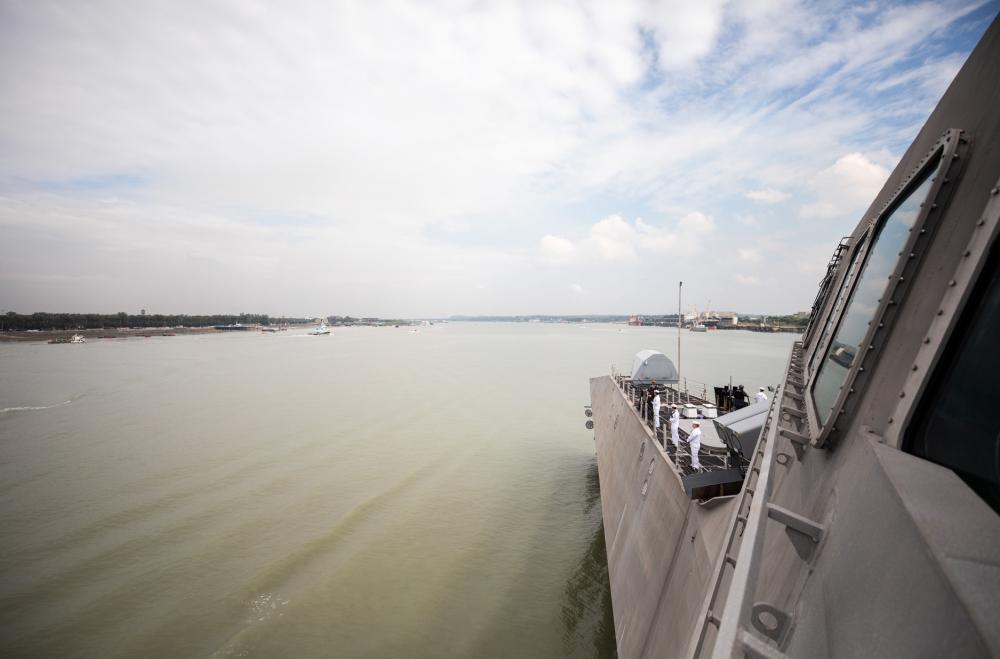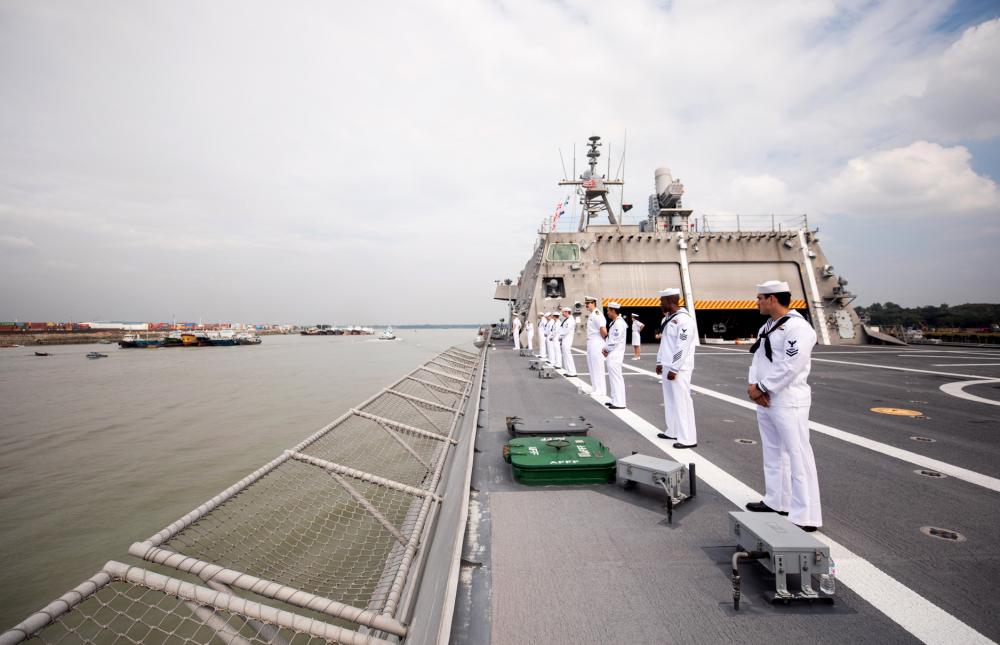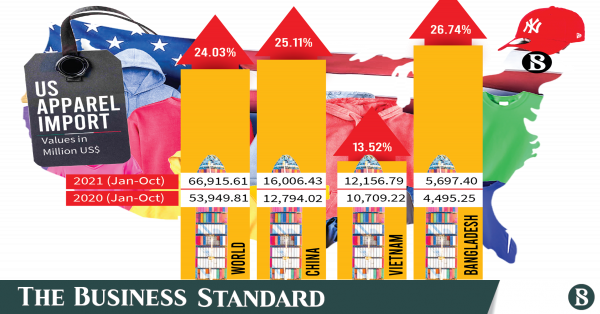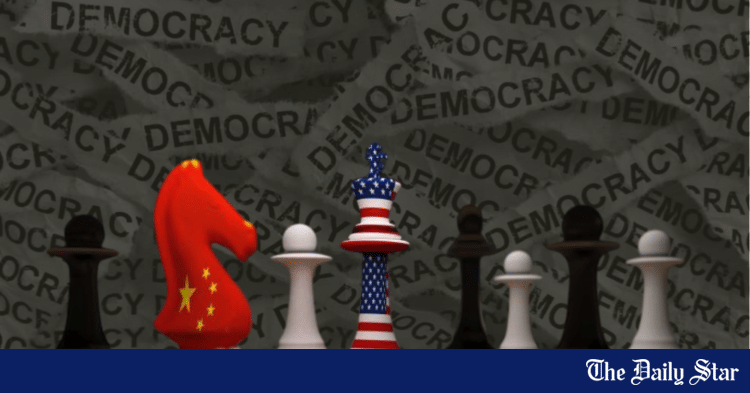Natural disasters, poverty, and overpopulation are the reductive lenses through which many international observers view Bangladesh. While the country's recent economic success has captured global attention, it is still rarely on the radars of strategic thinkers.
Yet Chinese Ambassador to Bangladesh Li Jiming recently delivered a useful reminder about Bangladesh's strategic significance when he warned that China-Bangladesh relations will suffer if Dhaka joins the Quad, an informal grouping that aims to counterbalance Beijing.
During its early years, Bangladesh suffered through military coups and economic stagnation. These conditions kept Bangladesh isolated globally for decades.
Even today, in South Asian geopolitical discourse, Bangladesh—when not ignored altogether—is often viewed through the prism of India, an influential player in the subcontinent's geopolitics, and of its other neighbors. But Bangladesh has major geopolitical value on its own merits, separate from India or any other country.
First, consider geography: Bangladesh borders India along the latter's seven northeastern states, including along the narrow yet highly strategic Siliguri Corridor that links these states to the rest of India. The northeast accounts for just 8% of India's territory, but has long been a restive area home to multiple separatist movements.
Northeast India also borders China, which maintains a claim to the Indian state of Arunachal Pradesh. During a 2017 India-China border crisis in the Doklam plateau—located on the northeastern side of the Siliguri Corridor—India initiated a massive force mobilisation via this narrow corridor.
This could well happen again in the event of a future Sino-Indian border clash in Arunachal Pradesh, or if India seeks to upgrade its northeast military forces in response to a renewed separatist outbreak.
If Bangladesh were to take the side of China or India, or to exert any role, whether diplomatic or military, in future crises, there would be considerable geopolitical consequences for the region.
Additionally, Bangladesh's location means it holds significant strategic value for Beijing. China relies on the Strait of Malacca, a narrow waterway between Malaysia, Singapore, and the Indonesian island of Sumatra, to import energy and goods from the Middle East and Africa via the Indian Ocean.
The Strait of Malacca could become a high-risk passageway in the event of a potential conflict either in the South China Sea or the India-China border. Consequently, China has taken a number of initiatives to build alternative routes aimed at reducing dependence on the Strait of Malacca. Seeking port facilities in the Indian Ocean and Bay of Bengal region along with overland connections to them is one of the efforts in this direction.
Though China shares no border with Bangladesh, the distance between the two countries is only about 100 kilometers. Beijing hopes to bridge this distance through infrastructure that would link the two countries closer.
The Bangladesh-China-India-Myanmar Economic Corridor is one of the six proposed economic corridors of China's Belt and Road Initiative (BRI). It views Bangladesh as a central location for Beijing's strategic advances in the Indian Ocean.
Bangladesh's economic profile is a second reason for its geopolitical value. It is home to one of the world's most competitive garment industries, and it receives high levels of remittances from the millions of Bangladeshis employed in the Gulf states, the United States, and the United Kingdom.
The Bangladeshi economy has boomed at an annual average growth rate of about 7% for the past two decades. Bangladesh's GDP per capita stands at $2,227, higher than India's at $1,947 and much higher than Pakistan's at $1,543.
With a GDP of over $352 billion, Bangladesh has the 41st largest economy in the world and the second largest in South Asia, only behind India. Bangladesh is projected to have the world's 28th-largest economy by 2030.
Bangladesh's vibrant labour economy is fueled by its large, young population. 20% of its population is between the ages of 15 and 24 in a country of 165 million people. And unlike many other Muslim-majority countries, there is strong female labor participation in the Bangladeshi economy.
Indeed, the economic empowerment of women is one of the fundamental reasons for Bangladesh's remarkable growth story in recent decades. More broadly, on many social indicators—not just women's empowerment but also life expectancy and birth rates—Bangladesh performs better than India and other South Asian countries.
Bangladesh's relatively stable investment and security climates—Islamist extremism, while a reality, has largely been kept in check—offer major market potential for the world, and Dhaka is starting to leverage its economic successes for geopolitical gains.
The recent announcement that it will provide $200 million in aid to Sri Lanka not only defies the stereotype of Bangladesh as an impoverished supplicant state, it also showcases its status as an increasingly influential regional player.
A third reason for Bangladesh's geopolitical importance is its military contributions to global peace and security. Even with its moderately sized armed forces, Bangladesh is the top troop contributor to UN peacekeeping missions, with forces currently deployed in eight countries.
It makes these contributions for several reasons: to strengthen its global image, to demonstrate its active role in multilateral organisations and activities, and to expand its diplomatic relations through building stronger friendships in the countries where its peacekeeping forces are based.
This is in addition to Bangladesh's non-military global footprint: Dhaka plays an active role in regional and international forums such as the South Asian Association for Regional Cooperation (SAARC), the Bay of Bengal Initiative for Multi-Sectoral Technical and Economic Cooperation (BIMSTEC), and the UN agencies.
Bangladesh provides a strategic opportunity for the United States. By pursuing a deeper partnership with Dhaka, Washington can bolster efforts by the United States and its Australian, Indian, and Japanese Quad partners to counterbalance Chinese power in the Indo-Pacific region.
US diplomacy, however, must be careful. Bangladesh wants to balance its relations with Beijing and New Delhi, even while it has increased its economic ties to China in recent years. This is why it is essential that Washington pursue a stronger relationship with Dhaka on its own merits, and not simply to bring Bangladesh into an anti-China camp.
Much like India in the early 1990s, Bangladesh's recent economic rise and social mobilisation have prompted the country to adopt a more global outward stance after decades of isolationism. One of the biggest indications of this foreign policy shift is Bangladesh's growing engagement with China.
Dhaka's relations with Beijing have improved significantly since China launched BRI in 2013, and the two upgraded their relations to a strategic partnership in 2016 during President Xi Jinping's visit to Bangladesh as the first Chinese head of state in 30 years.
China is now Bangladesh's top trading partner, direct foreign investor, trade importer, and military hardware supplier. China also recently granted duty-free access to its market to 97% of Bangladeshi products.
China's courtship of Bangladesh is part of a systematic strategy aimed at expanding Beijing's global influence. China uses infrastructure—and, more recently, Covid-19 vaccine diplomacy—to secure greater influence over South Asian states, including Bangladesh.
This has prompted some analysts to fear that Bangladesh—even as it continues to enjoy good relations with China's rival India—could soon become the next South Asian country, after Sri Lanka, Pakistan, and Nepal, to fall into China's orbit.
Bangladesh's growing engagement with China worries India. As South Asia's largest and most influential player, India wants the entire region to be within its sphere of influence. Given its decades-long hostility with Pakistan and indications that Sri Lanka and Nepal are now hedging toward Beijing, New Delhi worries that Bangladesh, a traditional regional partner, may follow suit.
India has therefore deployed a wide variety of tools, from economic incentives to public diplomacy, to counter Chinese influence and maintain its predominance in the region. For example, in 2017, India announced $5 billion in loans for Bangladesh—the largest-ever Indian expenditure in the country—after Dhaka signed onto BRI and Beijing promised $24 billion in assistance to Bangladesh.
More recently, before India's own pandemic wave this past spring, India sought to ramp up its provision of Covid-19 vaccines to Bangladesh, soon after Dhaka received masks from Beijing. (India later had to suspend its vaccine supply commitments due to emergency needs at home.)
Consequently, Dhaka is at risk of becoming embroiled in a China-India tug of war for regional influence. Bangladesh has so far avoided this trap by maintaining balanced relations with both, emphasising its political and cultural links with India and its economic ties with China.
But Bangladesh is also trying to extend this balancing act into geopolitics. Earlier this year, Gowher Rizvi, international affairs advisor to Bangladeshi Prime Minister Sheikh Hasina, stated that Bangladesh is a part of BRI but also wants to be part of the "Indo-Pacific relationship"—a clear reference to the US Indo Pacific policy, which is strongly endorsed by New Delhi and is meant to counterbalance China.
This balancing act will grow more challenging for Bangladesh amid growing and increasingly tense great-power competition in the region, and especially if relations between Beijing and New Delhi get worse.
Bangladesh's motivations are less about growing fondness for China, however, and more about geopolitical realities in South Asia and long-term dissatisfaction with India.
Many Bangladeshis would not want to see their country go the way of Chinese-style authoritarianism, and while they admire China's economic successes, they have little appetite for communism.
Meanwhile, New Delhi's generally cordial relationship with Dhaka has experienced bumps during Indian Prime Minister Narendra Modi's tenure. This can be attributed in part to Modi's Hindu nationalist agenda and the muscular foreign policy he has pursued in the region. For instance, New Delhi angered Dhaka by passing a law in 2019 that fast-tracks Indian citizenship for persecuted non-Muslim religious minorities fleeing neighboring states.
Dhaka opposes this law, believing it to be based on the supposition that Bangladesh persecutes its religious minorities and that it will result in the Indian expulsion of Bengali Muslim migrants back to Bangladesh. While Dhaka's public criticism has been soft, it sent a strong message by calling off a series of high-level meetings with India after the law was finalised in 2019.
Additionally, Modi's Hindu nationalist politics have increased tensions between the Hindu and Muslim communities in both India and Bangladesh, resulting in violent clashes in both countries.
Hasina's statements about these clashes, including a warning to New Delhi not to let communal violence in India impact Bangladesh, suggest India's religion-based politics could continue to pose a problem for bilateral relations.
There are also longer-standing tension points, including the killings of Bangladeshis by Indian border troops and India's refusal to finalise a transboundary water agreement with Bangladesh for the Teesta River.
By contrast, China has pushed full speed ahead with BRI, bringing the Chinese signature project deeper into South Asia, including Bangladesh, where it finds a country keen to secure new infrastructure investment—a major need amid rapid economic growth and urbanisation.
Bangladesh, like many countries housing BRI investments, is attracted to Beijing's ability to quickly deploy large amounts of capital with relatively few conditions. This is not something that New Delhi—or, for that matter, Washington—is able to do.
The Biden administration has retained many elements of the Trump administration's Indo-Pacific policy, including the pursuit of infrastructure and other investments to counterbalance China and BRI. Seen in this light, investing US strategic capital in Bangladesh could pay positive dividends for Washington.
Consider, for example, Bangladesh's strategic location in the Bay of Bengal, its status as a relatively moderate Muslim majority country of 165 million people, and its strong economic growth.
It has been a significant global player in efforts to fight extremism and climate change. And of course, deeper engagement with Dhaka can help prevent the country from falling completely into China's camp.
A concrete way to do this is to provide Bangladesh with two key needs: infrastructure and military hardware. Bangladesh's recent tilt toward Beijing is driven strictly by economic factors.
By funneling more investments into Bangladesh, increasing security cooperation with Dhaka and, most importantly, showing a real interest in the country as a strategic player with agency, the Biden administration could construct a much stronger and sustainable US-Bangladesh relationship.
There are some obstacles, of course. While Washington is trying to ramp up its overseas infrastructure assistance capacities through new tools like the International Development Finance Corporation and the Blue Dot Network, as well as the G-7's new Build Back Better World global infrastructure project, it cannot hold a candle to Beijing's ability to quickly provide large amounts of infrastructure assistance.
Still, for Washington, the strategic imperative of deeper engagement cannot be overstated. But US diplomacy must be cautious. Washington must be mindful of Bangladesh's sensitivities.
Given its recent tensions with India and its desire to be seen as a strategic actor in its own right, Dhaka would not react well if US policy continues to deal with Dhaka via New Delhi.
If Bangladesh perceives that the United States, along with Quad partners Japan and Australia, are of too much importance to India in South Asian policy considerations, Dhaka's concerns about India—driven by perceptions that the region's most powerful country engages in bullying regional behavior—will become magnified. In such a scenario, Bangladesh would be reluctant to get closer to America.
Dhaka would want to use closer ties with the United States as leverage to set better terms for Bangladesh's relationship with India.
If the United States were to pressure Bangladesh to support the Quad but failed to respect its concerns about India, Dhaka could choose instead to move closer to Beijing to balance India. When the Chinese envoy to Dhaka issued his warning about Bangladesh joining the Quad, he may have been playing on these Bangladeshi insecurities.
The right way for Washington to approach Dhaka is to view better relations between the two countries as a good thing in and of itself as well as a logical next step given Bangladesh's economic rise.
The wrong way to approach Bangladesh is to try to bring it into an anti-China condominium—an outcome that risks alienating Beijing, a key Bangladeshi economic partner, while depriving Dhaka of leverage over New Delhi.
At the end of the day, Bangladesh's core foreign policy is similar to India's: Dhaka does not want to pick sides. It wants to diversify its engagements with multiple actors in order to bolster its ability to act independently and on its own terms.
If Washington and its Quad partners understand this basic reality, they will be more successful in strengthening relations with Dhaka—and achieving their broader goals in the Indo-Pacific.
Anu Anwar is a fellow at Harvard University's Faculty of Arts and Sciences and a PhD student at the Johns Hopkins University School of Advanced International Studies.
Michael Kugelman is the writer of Foreign Policy's weekly South Asia Brief. He is the Asia Program deputy director and senior associate for South Asia at the Wilson Center in Washington.
Disclaimer: This article first appeared on Foreign Policy, and is edited and published by special syndication arrangement.

 publisher.tbsnews.net
publisher.tbsnews.net
Yet Chinese Ambassador to Bangladesh Li Jiming recently delivered a useful reminder about Bangladesh's strategic significance when he warned that China-Bangladesh relations will suffer if Dhaka joins the Quad, an informal grouping that aims to counterbalance Beijing.
During its early years, Bangladesh suffered through military coups and economic stagnation. These conditions kept Bangladesh isolated globally for decades.
Even today, in South Asian geopolitical discourse, Bangladesh—when not ignored altogether—is often viewed through the prism of India, an influential player in the subcontinent's geopolitics, and of its other neighbors. But Bangladesh has major geopolitical value on its own merits, separate from India or any other country.
First, consider geography: Bangladesh borders India along the latter's seven northeastern states, including along the narrow yet highly strategic Siliguri Corridor that links these states to the rest of India. The northeast accounts for just 8% of India's territory, but has long been a restive area home to multiple separatist movements.
Northeast India also borders China, which maintains a claim to the Indian state of Arunachal Pradesh. During a 2017 India-China border crisis in the Doklam plateau—located on the northeastern side of the Siliguri Corridor—India initiated a massive force mobilisation via this narrow corridor.
This could well happen again in the event of a future Sino-Indian border clash in Arunachal Pradesh, or if India seeks to upgrade its northeast military forces in response to a renewed separatist outbreak.
If Bangladesh were to take the side of China or India, or to exert any role, whether diplomatic or military, in future crises, there would be considerable geopolitical consequences for the region.
Additionally, Bangladesh's location means it holds significant strategic value for Beijing. China relies on the Strait of Malacca, a narrow waterway between Malaysia, Singapore, and the Indonesian island of Sumatra, to import energy and goods from the Middle East and Africa via the Indian Ocean.
The Strait of Malacca could become a high-risk passageway in the event of a potential conflict either in the South China Sea or the India-China border. Consequently, China has taken a number of initiatives to build alternative routes aimed at reducing dependence on the Strait of Malacca. Seeking port facilities in the Indian Ocean and Bay of Bengal region along with overland connections to them is one of the efforts in this direction.
Though China shares no border with Bangladesh, the distance between the two countries is only about 100 kilometers. Beijing hopes to bridge this distance through infrastructure that would link the two countries closer.
The Bangladesh-China-India-Myanmar Economic Corridor is one of the six proposed economic corridors of China's Belt and Road Initiative (BRI). It views Bangladesh as a central location for Beijing's strategic advances in the Indian Ocean.
Bangladesh's economic profile is a second reason for its geopolitical value. It is home to one of the world's most competitive garment industries, and it receives high levels of remittances from the millions of Bangladeshis employed in the Gulf states, the United States, and the United Kingdom.
The Bangladeshi economy has boomed at an annual average growth rate of about 7% for the past two decades. Bangladesh's GDP per capita stands at $2,227, higher than India's at $1,947 and much higher than Pakistan's at $1,543.
With a GDP of over $352 billion, Bangladesh has the 41st largest economy in the world and the second largest in South Asia, only behind India. Bangladesh is projected to have the world's 28th-largest economy by 2030.
Bangladesh's vibrant labour economy is fueled by its large, young population. 20% of its population is between the ages of 15 and 24 in a country of 165 million people. And unlike many other Muslim-majority countries, there is strong female labor participation in the Bangladeshi economy.
Indeed, the economic empowerment of women is one of the fundamental reasons for Bangladesh's remarkable growth story in recent decades. More broadly, on many social indicators—not just women's empowerment but also life expectancy and birth rates—Bangladesh performs better than India and other South Asian countries.
Bangladesh's relatively stable investment and security climates—Islamist extremism, while a reality, has largely been kept in check—offer major market potential for the world, and Dhaka is starting to leverage its economic successes for geopolitical gains.
The recent announcement that it will provide $200 million in aid to Sri Lanka not only defies the stereotype of Bangladesh as an impoverished supplicant state, it also showcases its status as an increasingly influential regional player.
A third reason for Bangladesh's geopolitical importance is its military contributions to global peace and security. Even with its moderately sized armed forces, Bangladesh is the top troop contributor to UN peacekeeping missions, with forces currently deployed in eight countries.
It makes these contributions for several reasons: to strengthen its global image, to demonstrate its active role in multilateral organisations and activities, and to expand its diplomatic relations through building stronger friendships in the countries where its peacekeeping forces are based.
This is in addition to Bangladesh's non-military global footprint: Dhaka plays an active role in regional and international forums such as the South Asian Association for Regional Cooperation (SAARC), the Bay of Bengal Initiative for Multi-Sectoral Technical and Economic Cooperation (BIMSTEC), and the UN agencies.
Bangladesh provides a strategic opportunity for the United States. By pursuing a deeper partnership with Dhaka, Washington can bolster efforts by the United States and its Australian, Indian, and Japanese Quad partners to counterbalance Chinese power in the Indo-Pacific region.
US diplomacy, however, must be careful. Bangladesh wants to balance its relations with Beijing and New Delhi, even while it has increased its economic ties to China in recent years. This is why it is essential that Washington pursue a stronger relationship with Dhaka on its own merits, and not simply to bring Bangladesh into an anti-China camp.
Much like India in the early 1990s, Bangladesh's recent economic rise and social mobilisation have prompted the country to adopt a more global outward stance after decades of isolationism. One of the biggest indications of this foreign policy shift is Bangladesh's growing engagement with China.
Dhaka's relations with Beijing have improved significantly since China launched BRI in 2013, and the two upgraded their relations to a strategic partnership in 2016 during President Xi Jinping's visit to Bangladesh as the first Chinese head of state in 30 years.
China is now Bangladesh's top trading partner, direct foreign investor, trade importer, and military hardware supplier. China also recently granted duty-free access to its market to 97% of Bangladeshi products.
China's courtship of Bangladesh is part of a systematic strategy aimed at expanding Beijing's global influence. China uses infrastructure—and, more recently, Covid-19 vaccine diplomacy—to secure greater influence over South Asian states, including Bangladesh.
This has prompted some analysts to fear that Bangladesh—even as it continues to enjoy good relations with China's rival India—could soon become the next South Asian country, after Sri Lanka, Pakistan, and Nepal, to fall into China's orbit.
Bangladesh's growing engagement with China worries India. As South Asia's largest and most influential player, India wants the entire region to be within its sphere of influence. Given its decades-long hostility with Pakistan and indications that Sri Lanka and Nepal are now hedging toward Beijing, New Delhi worries that Bangladesh, a traditional regional partner, may follow suit.
India has therefore deployed a wide variety of tools, from economic incentives to public diplomacy, to counter Chinese influence and maintain its predominance in the region. For example, in 2017, India announced $5 billion in loans for Bangladesh—the largest-ever Indian expenditure in the country—after Dhaka signed onto BRI and Beijing promised $24 billion in assistance to Bangladesh.
More recently, before India's own pandemic wave this past spring, India sought to ramp up its provision of Covid-19 vaccines to Bangladesh, soon after Dhaka received masks from Beijing. (India later had to suspend its vaccine supply commitments due to emergency needs at home.)
Consequently, Dhaka is at risk of becoming embroiled in a China-India tug of war for regional influence. Bangladesh has so far avoided this trap by maintaining balanced relations with both, emphasising its political and cultural links with India and its economic ties with China.
But Bangladesh is also trying to extend this balancing act into geopolitics. Earlier this year, Gowher Rizvi, international affairs advisor to Bangladeshi Prime Minister Sheikh Hasina, stated that Bangladesh is a part of BRI but also wants to be part of the "Indo-Pacific relationship"—a clear reference to the US Indo Pacific policy, which is strongly endorsed by New Delhi and is meant to counterbalance China.
This balancing act will grow more challenging for Bangladesh amid growing and increasingly tense great-power competition in the region, and especially if relations between Beijing and New Delhi get worse.
Bangladesh's motivations are less about growing fondness for China, however, and more about geopolitical realities in South Asia and long-term dissatisfaction with India.
Many Bangladeshis would not want to see their country go the way of Chinese-style authoritarianism, and while they admire China's economic successes, they have little appetite for communism.
Meanwhile, New Delhi's generally cordial relationship with Dhaka has experienced bumps during Indian Prime Minister Narendra Modi's tenure. This can be attributed in part to Modi's Hindu nationalist agenda and the muscular foreign policy he has pursued in the region. For instance, New Delhi angered Dhaka by passing a law in 2019 that fast-tracks Indian citizenship for persecuted non-Muslim religious minorities fleeing neighboring states.
Dhaka opposes this law, believing it to be based on the supposition that Bangladesh persecutes its religious minorities and that it will result in the Indian expulsion of Bengali Muslim migrants back to Bangladesh. While Dhaka's public criticism has been soft, it sent a strong message by calling off a series of high-level meetings with India after the law was finalised in 2019.
Additionally, Modi's Hindu nationalist politics have increased tensions between the Hindu and Muslim communities in both India and Bangladesh, resulting in violent clashes in both countries.
Hasina's statements about these clashes, including a warning to New Delhi not to let communal violence in India impact Bangladesh, suggest India's religion-based politics could continue to pose a problem for bilateral relations.
There are also longer-standing tension points, including the killings of Bangladeshis by Indian border troops and India's refusal to finalise a transboundary water agreement with Bangladesh for the Teesta River.
By contrast, China has pushed full speed ahead with BRI, bringing the Chinese signature project deeper into South Asia, including Bangladesh, where it finds a country keen to secure new infrastructure investment—a major need amid rapid economic growth and urbanisation.
Bangladesh, like many countries housing BRI investments, is attracted to Beijing's ability to quickly deploy large amounts of capital with relatively few conditions. This is not something that New Delhi—or, for that matter, Washington—is able to do.
The Biden administration has retained many elements of the Trump administration's Indo-Pacific policy, including the pursuit of infrastructure and other investments to counterbalance China and BRI. Seen in this light, investing US strategic capital in Bangladesh could pay positive dividends for Washington.
Consider, for example, Bangladesh's strategic location in the Bay of Bengal, its status as a relatively moderate Muslim majority country of 165 million people, and its strong economic growth.
It has been a significant global player in efforts to fight extremism and climate change. And of course, deeper engagement with Dhaka can help prevent the country from falling completely into China's camp.
A concrete way to do this is to provide Bangladesh with two key needs: infrastructure and military hardware. Bangladesh's recent tilt toward Beijing is driven strictly by economic factors.
By funneling more investments into Bangladesh, increasing security cooperation with Dhaka and, most importantly, showing a real interest in the country as a strategic player with agency, the Biden administration could construct a much stronger and sustainable US-Bangladesh relationship.
There are some obstacles, of course. While Washington is trying to ramp up its overseas infrastructure assistance capacities through new tools like the International Development Finance Corporation and the Blue Dot Network, as well as the G-7's new Build Back Better World global infrastructure project, it cannot hold a candle to Beijing's ability to quickly provide large amounts of infrastructure assistance.
Still, for Washington, the strategic imperative of deeper engagement cannot be overstated. But US diplomacy must be cautious. Washington must be mindful of Bangladesh's sensitivities.
Given its recent tensions with India and its desire to be seen as a strategic actor in its own right, Dhaka would not react well if US policy continues to deal with Dhaka via New Delhi.
If Bangladesh perceives that the United States, along with Quad partners Japan and Australia, are of too much importance to India in South Asian policy considerations, Dhaka's concerns about India—driven by perceptions that the region's most powerful country engages in bullying regional behavior—will become magnified. In such a scenario, Bangladesh would be reluctant to get closer to America.
Dhaka would want to use closer ties with the United States as leverage to set better terms for Bangladesh's relationship with India.
If the United States were to pressure Bangladesh to support the Quad but failed to respect its concerns about India, Dhaka could choose instead to move closer to Beijing to balance India. When the Chinese envoy to Dhaka issued his warning about Bangladesh joining the Quad, he may have been playing on these Bangladeshi insecurities.
The right way for Washington to approach Dhaka is to view better relations between the two countries as a good thing in and of itself as well as a logical next step given Bangladesh's economic rise.
The wrong way to approach Bangladesh is to try to bring it into an anti-China condominium—an outcome that risks alienating Beijing, a key Bangladeshi economic partner, while depriving Dhaka of leverage over New Delhi.
At the end of the day, Bangladesh's core foreign policy is similar to India's: Dhaka does not want to pick sides. It wants to diversify its engagements with multiple actors in order to bolster its ability to act independently and on its own terms.
If Washington and its Quad partners understand this basic reality, they will be more successful in strengthening relations with Dhaka—and achieving their broader goals in the Indo-Pacific.
Anu Anwar is a fellow at Harvard University's Faculty of Arts and Sciences and a PhD student at the Johns Hopkins University School of Advanced International Studies.
Michael Kugelman is the writer of Foreign Policy's weekly South Asia Brief. He is the Asia Program deputy director and senior associate for South Asia at the Wilson Center in Washington.
Disclaimer: This article first appeared on Foreign Policy, and is edited and published by special syndication arrangement.

America should bet on Bangladesh
Bangladesh has major geopolitical value on its own merits, separate from India or any other country


